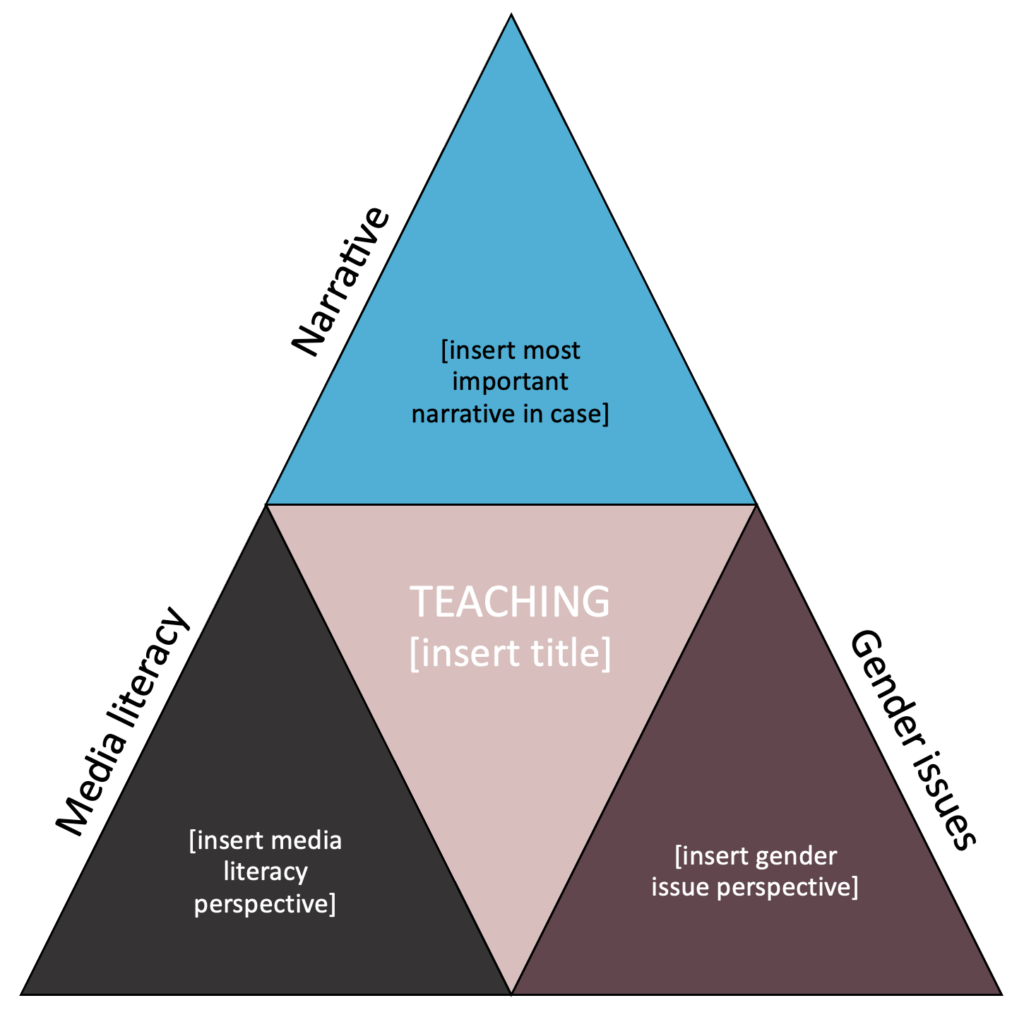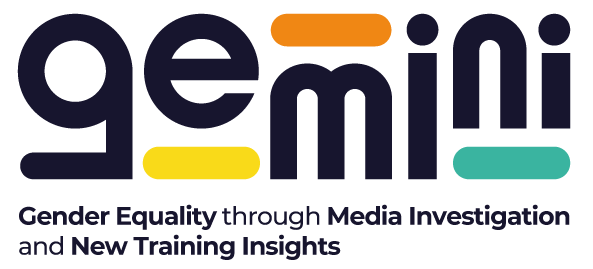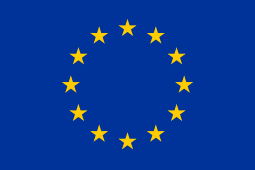The GEMINI pedagogical triangle
From watching serial drama to teaching gender issues
By Louise Brix Jacobsen and Kim Toft Hansen, 12 August 2024
The GEMINI research project presents a research-action approach to gender equality. While research is the basis from which we develop our thinking about how serial drama may facilitate a constructive dialogue about gender issues, the action part of the project centres principally on presenting new ways of teaching gender equality to high school students by using serial drama as a pedagogical tool.
This short article presents the GEMINI pedagogical triangle as a flexible and an easy-to-use teachers’ tool. It discloses the elementary pedagogical perspectives imbedded in its use, while it refers to illustrative examples of how the triangle may be put to use. The triangle is not a new revolutionary tool; rather, it is a straightforward way to facilitate modes of thought in a basic teaching context.
Narrative, media, gender
The objective of the pedagogical triangle is to find short and usable excerpts from series that present ample material for singling out specific concepts to teach students. For both teachers and students, time in the classroom and for preparation is often pressured and fleeting, which means that it is difficult to teach long-running series or even full episodes from important serial dramas, since teachers and students simply do not have the time to watch hours of series. Instead, GEMINI suggests using 3-5-minute excerpts that are not only representative for the series as a whole, but also demonstrate opportunities to explore particular gender and media concepts.
The pedagogical triangle (see model below) is a simple tool that presents a way for a teacher to plan specific focus points for teaching gender issues in and through a serial drama. Through three different ‘corners’, the model presents an opportunity to ‘close in on’ a a) narrative focus, b) a specific media literacy area, and c) a certain gender issue. On the one hand, this provides an opportunity for GEMINI researchers to present simple examples and excerpts from series. On the other hand, its simplicity makes in suitable for teachers own insertion of examples and, in this way, develop new teaching material for relevant new series or local and more appropriate series.
One series, one scene, one issue
Using 3-5-minute excerpts displays how a one series, one scene, one issue dogma has been important to expose how high schools’ pedagogical context necessitates a “case-neutral” approach to teaching gender through serial drama. Firstly, the basic GEMIMI dogma highlights how well-chosen and representative scenes from series may expose one gender issue that may be explored further from a theoretical and analytical point of view by the teacher together with students.
Secondly, case-neutrality in modelling pedagogical approaches to serial drama and gender issues means that local teachers may use scenes and series proposed by GEMINI researchers to understand how the grid or methodical approach works, but in the end the teacher will be able to continuously replace the cases while sticking to the overall outline of teaching important gender issues from scene excerpts from series. Case-neutrality, then, speaks to the longevity of GEMINI as a research project since GEMINI scholars acknowledge that what is important to high school students now and which cases are interesting to teach now will not necessarily remain important and interesting. Future cases may be easily inserted in to the ‘logic’ of the model (see template below).

The logic of the model implies a three-way work process. Firstly, the teacher needs to understand the basics of the narrative. This does involve working with the series in question, but watching opening episodes of serial drama often provides an entry point from which it is possible to decode dominant narrative focal points of a series. Secondly, using serial drama needs a media literacy perspective, since series are no neutral window to social issues. Often series frame its topics in a certain way, e.g. by focalising the narrative through specific characters, which often presents an opportunity for teachers to teach how the issues of the drama are often told through the perspective of one or more characters. Thirdly, series dealing with gender issues may often narrate stories about different conflicts and issues, but in a teaching context it may be convenient to inspect only one gender issue, since such complex issues may need a gentle ‘unpacking’ in dialogue with students.
Altogether, this three-way approach provides insights into a serial drama’s overall intentions but launches attention towards relevant and insightful analyses of media exposure of gender topics. Essentially, the narrative focus presents the ‘what’ of the exercise; the emphasis on media literacy accentuates the ‘how’ of the exercise; the gender perspective highlights the interpretative ‘why’ of the exercise.

From ready-made to ready-to-make
The dynamics of the case-neutral grid marks an entry point for teachers to use the approach to facilitate local approaches to gender issues utilizing both local and international cases as teaching material. During the lifespan of GEMINI, scholars develop interesting examples for the GEMINI website based on some of the cases presented in the GEMINI report D3.1 (see examples through the table below), but at the same time, scholars acknowledge that such cases are contemporary exemplifications of a merged teaching approach to media (serial drama) and social issues (gender).
In the end, the pedagogical triangle and the GEMINI approach to teaching gender through serial drama also suggest a situation where gender and series may facilitate an independent classroom exercise in which high school teachers themselves may choose case examples and illustrative excerpts to be inserted into the pedagogical triangle. GEMINI proposes a situation in which the teacher may, firstly, start from the material presented in some of ready-made examples. Secondly, teachers may use the approach to develop their own excerpts and examples.
Lastly, the approach may be a handy tool in establishing student activities that may involve students’ own development of creative material about gender topics in serial drama. Setting up an exercise where students should choose their own excerpts from a serial drama and perhaps rework the material into a social media entry may present them with a hands-on opportunity to not only work technically with practical media production (producing own excerpts), which may facilitate a better understanding of the way certain topics are exposed through style and point of view; it also establishes a direct way into contemplating and comprehending complex gender issues through students own creative work with specific series.

Student exercise
Students locate their own excerpts from series
When the teacher has become well-acquainted with using the easy-to-use GEMINI pedagogical triangle for teaching gender issues through serial drama, the teacher may present the students with an exercise that includes similar practises.
The following are some constructive questions that the teacher may ask students to make them reflect on media literacy perspectives and gender topics in serial drama.
- What is the series about and how is gender relationships approached in the series?
- Is gender issues debated directly in the series or is it part of an overall narrative about something else?
- How is the story told?
- How would you describe the style of the series?
- Through which characters (point of view) is the story told?
- Which specific gender topic is the most prevalent in the story?
- Why is this specific gender issue the most important?
- Please, locate a scene or sequence from the series (3-5 minutes) that pinpoints the series’ stance towards the gender topic in question.
- Why do you find this scene or sequence especially important?
If the teacher is well-versed in practical media production or wishes to apply creative media production to the exercise, it would be an obvious opportunity to have students work or rework the chosen scene or sequence into their own material with alternative editing, voice over, dialogue from the series or relevant musical score.
Nature of a sequence
The GEMINI publication series “Nature of a sequence” presents short articles in which the pedagogical triangle has been put to use. Have a look at how series are presented as teaching tools in relation to important gender issues and media perspectives. The examples of series offer a great number of teaching perspectives on gender issues.
| Title | Narrative | Media literacy | Gender issue |
| Wednesday | Character introduction and antagonism | Focalisation and structures of sympathy | Gender dynamics and stereotypes |
| Sex Education | Aftermath of sexual assault | Representation of gender-based trauma | Gender-based violence |
| Euphoria | ‘Naturalised’ gender issues in serial drama | Character structures of sympathy | Toxic masculinity and transgender issues |
| Breaking Bad | Male provider and character development | The male gaze in structures of sympathy | Masculinity and unintended gender-bias |
| Rita | Strong woman with male traits | Difficult women in character-based drama | Banal gender-bending and gender traits |
| The Young Offenders | Coming of age and conformity | Media codes of class and criminality | Male bravado, fumbling masculinity and unconventional mothers |
| Baby Reindeer | Female stalking of male victim | Body images and depictions of male vulnerability | Victimhood, social masculinity and body stereotypes |
In the end, GEMINI is merely presenting research that may be used directly in European high schools. This material also highlights how GEMINI’s action elements also rely of teachers own interest in developing teaching material for their own teaching.
Parts of the above text has also been presented in the GEMINI report “Understanding young adults and gender equality through serial drama” (D3.1). Some of the examples of series are also analysed in the report. The report will be available through the GEMINI website very soon.


